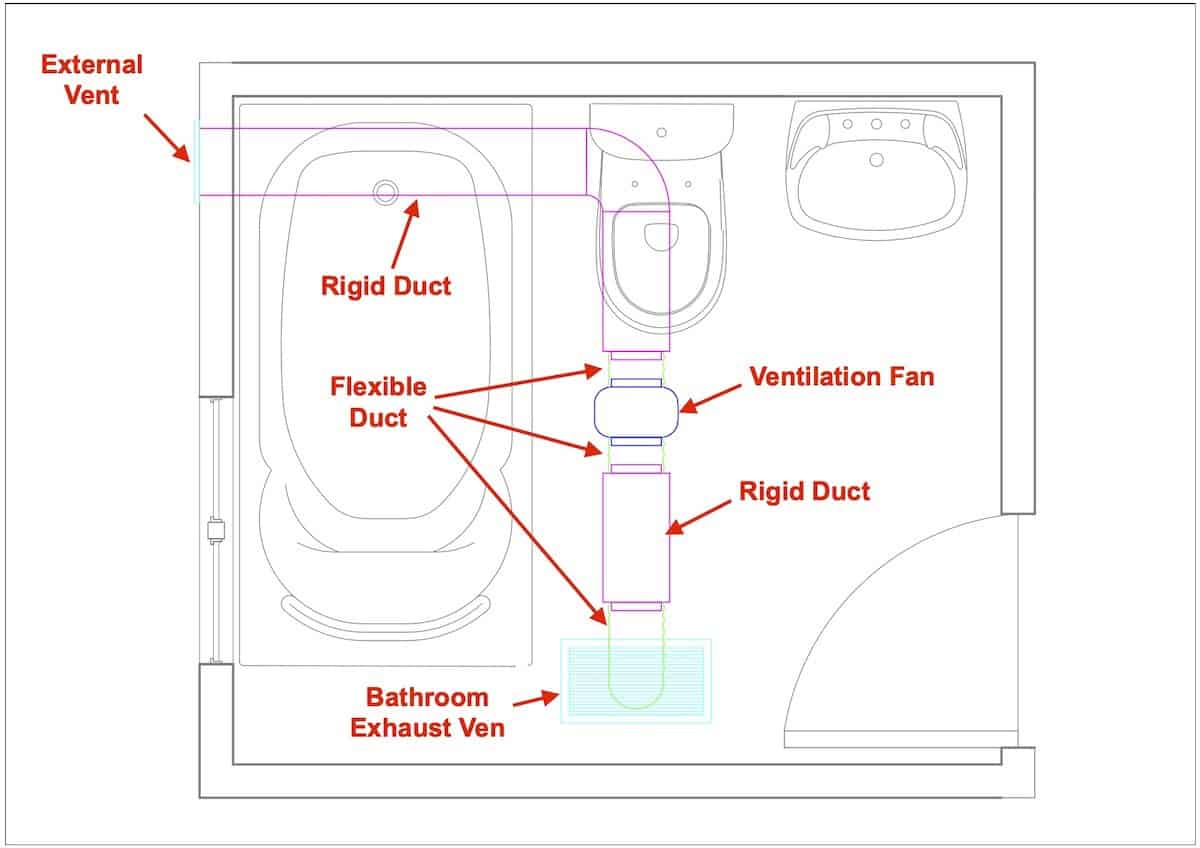Understanding Bathroom Fan Duct Diameters

Proper duct diameter is crucial for efficient bathroom fan operation. It ensures adequate airflow and prevents issues like noise, backdraft, and moisture accumulation. The optimal duct diameter depends on the fan’s CFM (cubic feet per minute) rating and the size of the bathroom.
Determining Optimal Duct Diameter
To determine the optimal duct diameter, consider the following guidelines:
– For fans with CFM rating up to 50 CFM: 3-inch diameter duct
– For fans with CFM rating between 50 and 100 CFM: 4-inch diameter duct
– For fans with CFM rating between 100 and 150 CFM: 5-inch diameter duct
– For fans with CFM rating over 150 CFM: 6-inch diameter duct
For bathrooms larger than 100 square feet, increase the duct diameter by one size.
Consequences of Undersized or Oversized Ducts
Using an undersized duct restricts airflow, causing the fan to work harder and produce more noise. It can also lead to backdraft, where air is drawn back into the bathroom instead of being exhausted.
An oversized duct allows too much airflow, which can reduce the fan’s efficiency and increase energy consumption. It can also create unnecessary noise and turbulence.
Materials and Installation Considerations: Bathroom Fan Duct Diameter

When it comes to bathroom fan ducts, there are several materials to choose from, each with its advantages and disadvantages. The most common materials include:
- PVC (Polyvinyl Chloride): PVC is a lightweight and inexpensive material that is easy to install. It is also resistant to corrosion and chemicals, making it a good choice for bathrooms with high humidity levels. However, PVC is not as durable as metal ducts and can be easily damaged if it is not properly installed.
- Metal: Metal ducts are more durable than PVC ducts and are less likely to be damaged. They are also more resistant to fire and heat, making them a good choice for bathrooms with high temperatures. However, metal ducts are more expensive than PVC ducts and can be more difficult to install.
- Flexible: Flexible ducts are made of a thin, flexible material that can be easily bent and shaped to fit into tight spaces. They are also lightweight and easy to install. However, flexible ducts are not as durable as PVC or metal ducts and can be easily damaged if they are not properly installed.
Once you have chosen the material for your bathroom fan duct, you will need to install it. The following steps will help you install a bathroom fan duct:
- Determine the location of the fan. The fan should be located in the center of the ceiling or wall, and it should be at least 6 inches away from any light fixtures or other obstructions.
- Cut a hole in the ceiling or wall. The hole should be the same size as the duct flange.
- Insert the duct flange into the hole. The flange should be flush with the surface of the ceiling or wall.
- Attach the duct to the flange. The duct should be secured to the flange with screws or nails.
- Seal the duct. The duct should be sealed with caulk or weatherstripping to prevent air leaks.
- Insulate the duct. The duct should be insulated with fiberglass or cellulose insulation to prevent heat loss.
It is important to seal and insulate the duct to prevent air leaks. Air leaks can reduce the efficiency of the fan and can also lead to condensation problems.
Troubleshooting and Maintenance

Bathroom fan duct diameter – Ensuring the optimal performance and longevity of your bathroom fan duct system requires regular maintenance and troubleshooting to address potential issues. Common problems associated with bathroom fan ducts include:
Clogged Ducts
- Cause: Accumulation of dust, hair, and debris within the duct.
- Solution: Regularly clean the duct by removing the cover and using a vacuum cleaner or brush to dislodge any obstructions.
Damaged Ducts
- Cause: Physical damage to the duct due to improper installation or external factors.
- Solution: Inspect the duct for any tears, punctures, or cracks and repair or replace the damaged section.
Noisy Operation
- Cause: Loose fan blades, misaligned ductwork, or obstructed airflow.
- Solution: Check the fan blades for tightness and adjust the ductwork to ensure proper alignment. Clear any obstructions that may be blocking the airflow.
Poor Ventilation
- Cause: Insufficient duct size, inadequate fan capacity, or blocked exhaust vent.
- Solution: Ensure the duct diameter is appropriate for the bathroom size and fan capacity. Replace the fan with a more powerful model if necessary. Clear any obstructions from the exhaust vent.
Importance of Regular Maintenance, Bathroom fan duct diameter
Regular maintenance of your bathroom fan duct system is crucial for:
- Ensuring optimal ventilation and air quality in the bathroom.
- Preventing the accumulation of moisture and mold growth.
- Extending the lifespan of the fan and duct system.
When considering the bathroom fan duct diameter, it’s crucial to ensure proper ventilation. For those seeking guidance on bathroom exhaust fan size in India, a comprehensive resource can be found at bathroom exhaust fan size india. By aligning the duct diameter with the fan’s capacity, you can effectively remove moisture and odors, ensuring a comfortable and healthy bathroom environment.
When considering bathroom fan duct diameter, it’s essential to ensure proper airflow and noise reduction. A 4 sones bathroom fan operates quietly, emitting only 4 units of sound, making it an ideal choice for peaceful relaxation. Maintaining the correct duct diameter is crucial for optimal performance, ensuring efficient ventilation and minimizing noise levels.